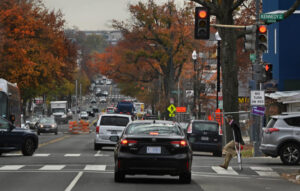NOVEMBER 25, 2024

A law banning cars from turning right at all red lights across D.C. was set to start with the new year. But city transportation officials, who never supported the blanket ban, have pumped the brakes because the D.C. Council failed to earmark money to alert drivers to the change.
As it stands, the city will only enforce a ban at about half of the District’s 1,600 intersections, where they have erected signs notifying drivers they can’t turn right on red. Sharon Kershbaum, director of the D.C. Department of Transportation, said a citywide ban was impractical, given the number of people traversing the roads who might not be familiar with the law.
“Many of the cars on our roads are coming from Maryland, Virginia, where it’s okay to turn right on red,” Kershbaum said. “We don’t think it’s safe … without signs to just assume that because it’s law of the land that people are going to be aware and comply with it.” She added that she thought any ad campaign would have “a real challenge getting to all possible drivers” and “doesn’t add any more value than our approach, that we can do with our current budget.”
The 2022 law enacting the ban required about $385,000 for “gateway” signs at entrances to the city and ads about the law in advance of citywide enforcement in 2025, but with the money to be budgeted later on. Charles Allen (D-Ward 6), head of the council’s transportation committee, said he believed DDOT could have found the funds in the city’s existing $21 billion budget.
“These are costs the agency can absorb — they are just choosing not to,” Allen said. “They don’t want to do it, so they’re choosing not to fund it.” He added that in earlier hearings, DDOT did not make clear that the lack of money would mean the ban was in limbo.
Former council member Elissa Silverman said that while DDOT could easily find such a small amount of money, lawmakers should have expected that the Bowser administration would not do it for them. The mayor did not sign the bill when it passed, indicating opposition.
“You need to put your money where your mouth is, especially when the mayor leaves a bill unsigned,” said Silverman, who lost her seat in 2022. “The council needs to fund the laws it wants implemented — otherwise they give the mayor an easy out.”
The council can allocate money for it in next year’s legislative session.
The change was one part of the Safer Streets Amendment Act, enacted as part of a broader effort to protect pedestrians and bicyclists, and reduce the number of collisions at intersections. Another section of the law, allowing cyclists to turn right at red lights and treat stop signs as yield signs, is in effect.
In the meantime, Kershbaum says DDOT is continuing a gradual expansion of right-on-red bans throughout the city that began in 2018 and has nearly reached its goal of placing signs at 1,000 of the District’s 1,600 intersections by the end of this year. All 55 active red-light cameras are at intersections where rights on red are banned and are already giving out tickets. But, Kershbaum said, whether to place signs at the remaining intersections will be decided on a case-by-case basis.
“We’ll put them up if we have a [community] request or we’re doing a corridor safety improvement and we think it would be helpful,” she said. “But we are not just going to put signs up at every intersection because of the law.” She said DDOT had attorneys “look closely at the legislation,” and they determined it wasn’t binding without the funding.
When the law passed in 2022, DDOT argued that it “will lead to low levels of compliance and confusion for drivers” if right turns on red were banned on streets without signs making that clear. Then-council member Mary M. Cheh (D-Ward 3), who proposed the ban, responded at the time that “even a low level of compliance … would result in a safer and more pedestrian friendly environment.” She also said the 2025 implementation date gave DDOT time to “educate the public” on the change.
Kalli Krumpos, advocacy director for the Washington Area Bicyclists Association, which helped push for the legislation, said the law and a vigorous public awareness campaign to highlight the changes are essential for safety.
“We know that 2023 was a 15-year high in traffic fatalities in D.C. and that is coming right before 2024, this year, which was supposed to be a year that D.C. reached Vision Zero, zero fatalities or serious injuries on our streets,” Krumpos said. “So obviously, we’re headed in the wrong direction.”
Krumpos said there has been a lack of transparency on the status of the law and on DDOT’s decision to focus on specific locations rather than a universal ban. “I think it will be really helpful to clarify current funding status of signs going up at those intersections and the continuing plans for implementation,” she said.
Everett Lott, who helmed DDOT when the law was passed, said he believed it was too broad to be effective. Like his successor, he advocated for expanding right-turn bans on a case-by-case basis focused on downtown.
“There are intersections throughout the city where pedestrians are definitely more vulnerable and more at risk potentially of being hit as they’re trying to cross than other locations,” Lott said. “There are some intersections and some locations where there’s very little volume, and if you ban the right on red in those locations, you’re going to end up encouraging some other bad behavior.” Drivers will try to go around cars stopped at the light, he said, and will get used to ignoring a ban that in other places is critical.
Lott noted that “the way the law is written — whether there’s a sign or not, you’re supposed to know the laws of the District.” But, he said, given how many people travel through D.C. from neighboring states where right turns at red lights are allowed, “it does make it more challenging from an enforceability perspective” and “also a little bit from a fairness perspective.”
Until recently, New York City was the only place in the country where turning right at all red lights was illegal. But with pedestrian fatalities rising, several cities have limited the practice and others are considering full bans.
Generally, studies indicate that right-turn-on-red collisions are rare but tend to lead to injuries for pedestrians and bicyclists. DDOT’s analysis of 74 intersections where the city has already banned right turns on red found “reduced conflicts,” both between drivers, and between drivers and pedestrians, with “minimal impacts on traffic flow.”
Like D.C., Cambridge, Massachusetts, moved to eliminate right turns at red lights in 2022. But state law wouldn’t let the city change the traffic codes, so Cambridge instead put up signs blocking the turns at each individual intersection — something the city already had the authority to do. They finished this year.
An adjustment to city code “would have been simpler,” said Cambridge’s Transportation Commissioner Brooke McKenna. “We always worry about sign fatigue, and it can be challenging to find the right locations to put up the signs.” But, she said, “It worked really well this way,” because without the signs, “it might be very confusing for folks from out of town.”
McKenna said traffic engineers do worry about the potential downside of putting restrictions in place that people are likely to ignore, such as stops signs at lightly used intersections. But for right on red, she argued, “if you’re consistent in your policy you’re likely to have higher compliance” — drivers don’t have to think about whether it’s in force or not.
“The value to protecting pedestrians and cyclists is so high from the right-turn restriction that it’s worth just making it across the board,” she added.
Courtesy/Source:The Washington Post










































































































